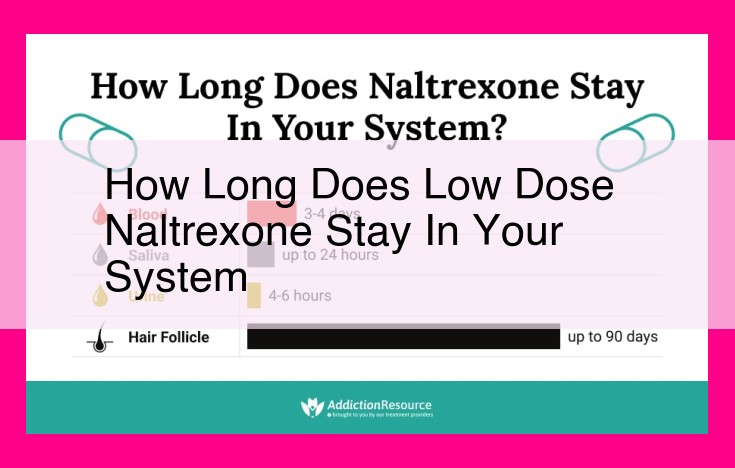Understanding Ldn Metabolism And Excretion: Key Factors For Treatment Efficacy

Low-dose naltrexone (LDN) metabolism and excretion processes impact its presence in the body. It undergoes hepatic metabolism, primarily through the cytochrome P450 system, and renal excretion. The half-life of LDN is approximately 12 hours, and it is typically undetectable in the system within 24-48 hours after administration. However, factors like liver health, renal function, and co-administered medications can influence its elimination rate, affecting its efficacy and potential side effects.
The Mechanism of Action of Naltrexone and Its Interaction with Mu-Opioid Receptors
Naltrexone, a medication commonly used to treat opioid addiction and alcohol dependence, exerts its effects by binding to the mu-opioid receptors in the brain. These receptors are responsible for the perception of pain, pleasure, and reward, and their activation by opioids leads to the characteristic euphoric effects of these substances. By blocking the action of opioids, naltrexone prevents them from interacting with mu-opioid receptors, thereby reducing their ability to produce sedation, analgesia, and respiratory depression.
The Role of Hepatic Metabolism and Renal Excretion in LDN Efficacy
Low-dose naltrexone (LDN) is an unconventional use of naltrexone involving the administration of significantly lower doses than those typically used for addiction treatment. At these lower doses, naltrexone exerts different effects, primarily by modulating the immune system and potentially alleviating chronic pain and fibromyalgia symptoms.
Hepatic metabolism plays a crucial role in the clearance of naltrexone from the body. The liver metabolizes naltrexone into inactive metabolites, which are then excreted by the kidneys. The rate of hepatic metabolism can vary significantly between individuals, impacting the duration of action and efficacy of LDN.
Renal excretion is also essential for eliminating naltrexone and its metabolites from the body. Impaired renal function can lead to the accumulation of naltrexone and its metabolites, potentially increasing the risk of side effects such as nausea, vomiting, and dizziness.
Pharmacological Factors Influencing LDN Efficacy
In the realm of Low-Dose Naltrexone (LDN) therapy, understanding the pharmacological factors that impact its effectiveness is crucial. One of these factors is the optimal dose and frequency of LDN administration.
Tailoring the LDN dosage to the individual and their specific condition is essential for maximizing its benefits. Various studies have explored the efficacy of different doses for different ailments. For instance, in alleviating opioid withdrawal symptoms, doses ranging from 0.5 mg to 4.5 mg per day have shown promising results. Similarly, for modulating the immune system, doses between 1.5 mg and 4.5 mg per day have been found to be effective.
Just as the dose, the frequency of LDN administration also plays a significant role in its efficacy. In most cases, a single daily dose is recommended. However, certain conditions may require a more frequent dosage regimen, such as twice a day or even three times a day. Adjustments to the frequency should be made under the guidance of a healthcare professional who is experienced in LDN therapy.
It’s important to note that LDN is not a one-size-fits-all medication. The optimal dose and frequency will vary depending on the individual’s weight, age, health conditions, and response to treatment. Regular monitoring by a healthcare professional is essential to ensure the effectiveness and safety of LDN therapy.
Physiological Factors Influencing Low-Dose Naltrexone (LDN) Efficacy
Understanding the physiological factors that influence LDN efficacy is crucial for optimizing its use. The liver and kidneys play pivotal roles in the drug’s metabolism and excretion, impacting its effectiveness.
Liver Health
The liver plays a central part in metabolizing LDN into its active form. Healthy liver function ensures the efficient conversion of LDN, maximizing its therapeutic benefits. Conversely, impaired liver function can diminish LDN’s efficacy as it may not be adequately metabolized.
Kidney Health
The kidneys primarily excrete LDN and its metabolites. Proper renal function ensures the timely elimination of these substances, allowing for regular dosing and sustained efficacy. In cases of impaired kidney function, LDN clearance may be delayed, leading to potential adverse events or altered efficacy.
Therefore, it is essential to assess liver and kidney health prior to initiating LDN therapy. Patients with underlying liver or kidney disorders may require individualized dosing adjustments or alternative treatment options. Monitoring liver and kidney function throughout treatment can further guide dosage decisions and ensure optimal outcomes.
Unveiling the Therapeutic Wonders of Low-Dose Naltrexone (LDN) in Clinical Settings
Alleviating the Burden of Opioid Withdrawal
For individuals struggling with opioid addiction, the withdrawal process can be excruciating and daunting. Low-dose naltrexone (LDN) has emerged as a promising therapy to alleviate these symptoms. By interfering with opioid receptors, LDN reduces the intensity of withdrawal cravings and withdrawal-related discomfort. Its efficacy in this area has garnered significant attention and support from the medical community.
Modulating the Immune System
Beyond its role in addiction recovery, LDN has also demonstrated remarkable therapeutic potential in modulating the immune system. In individuals with autoimmune diseases, LDN has shown promise in dampening excessive inflammation and restoring immune system balance. This unique ability holds immense promise for improving the lives of those affected by chronic inflammatory conditions.
Supporting Addiction Recovery
In the realm of addiction recovery, LDN plays a vital role in reducing cravings, preventing relapse, and promoting long-term abstinence. By targeting opioid receptors, LDN blocks the rewarding effects of opioids, making it less likely for individuals to engage in substance use. Furthermore, its ability to restore brain chemistry supports the recovery process by mitigating the underlying imbalances that contribute to addiction.